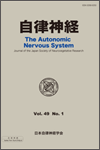
- Issue 4 Pages 188-
- Issue 3 Pages 170-
- Issue 2 Pages 123-
- Issue 1 Pages 2-
- |<
- <
- 1
- >
- >|
-
Masato Asahina2024Volume 61Issue 3 Pages 170-173
Published: 2024
Released on J-STAGE: September 27, 2024
JOURNAL FREE ACCESSImpairment of the central autonomic nervous system (CAN), including the hypothalamus, limbic system, and brainstem reticular formation, is exhibited by various autonomic symptoms and is also associated with sudden death. Sudden death often occurs in stroke patients, and it has been suggested to be related to the right insular cortex, which constitutes the limbic system. Sudden unexpected death in epilepsy (SUDEP) occurs in 1.2/1,000 persons per year in adult epilepsy patients, and it is speculated that apnea associated with postictal generalized EEG suppression following tonic-clonic seizure is the main cause of SUDEP. In autoimmune encephalitis such as NMDAR antibody encephalitis, symptoms of sympathetic overactivity such as tachycardia, hyperhidrosis, and hypertension are observed, whereas mental sweating on the palms may decrease, suggesting involvement of the amygdala. CAN impairment in neurological diseases affects prognosis, ADL, and QoL, and its evaluation is useful for understanding central nervous mechanisms.
View full abstractDownload PDF (259K)
-
Yoko Sunami, Natsuki Miyakoshi, Keizo Sugaya, Kazushi Takahashi2024Volume 61Issue 3 Pages 180-185
Published: 2024
Released on J-STAGE: September 27, 2024
JOURNAL FREE ACCESSOrthostatic intolerance following coronavirus disease 2019 (COVID-19), characterized by lightheadedness and palpitations, can severely impair the quality of life of some patients. Postural orthostatic tachycardia syndrome (POTS) is recognized as one of the manifestations of long COVID although its frequency and pathogenesis are still largely unknown. In the present study, POTS (COVID-POTS) was diagnosed in eight (12%) of the patients who visited our outpatient clinic with long COVID. All the patients with COVID-POTS had severe fatigue, and four (50%) required a leave of absence from work. However, all the patients experienced spontaneous recovery after their symptoms peaked, with the shortest leave of absence being three months from COVID-19 onset. A comparison of their clinical features with those of 24 patients with chronic POTS unrelated to COVID-19 found that most chronic POTS patients had abdominal symptoms, such as irritable bowel syndrome, which were associated with POTS severity while none of the COVID-POTS patients had abdominal symptoms.
View full abstractDownload PDF (456K)
- |<
- <
- 1
- >
- >|